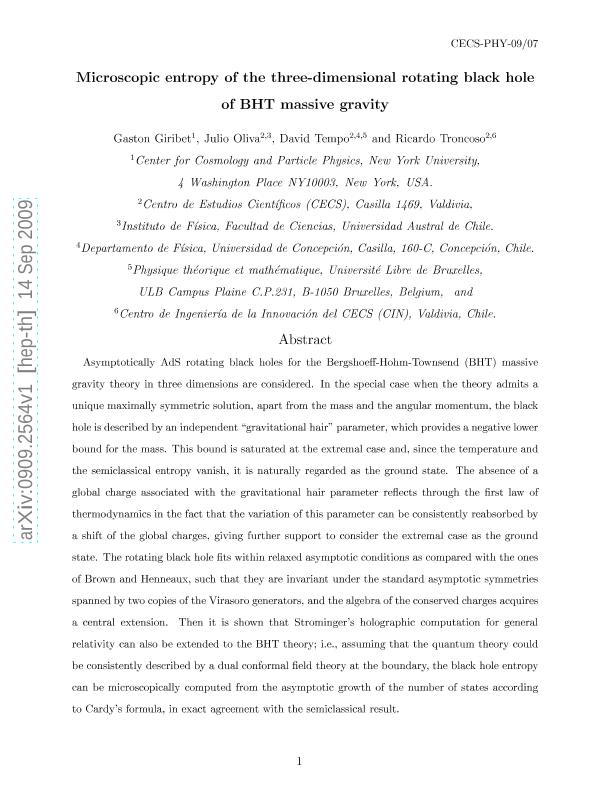Mostrar el registro sencillo del ítem
dc.contributor.author
Giribet, Gaston Enrique

dc.contributor.author
Oliva, Julio

dc.contributor.author
Tempo, David
dc.contributor.author
Troncoso, Ricardo
dc.date.available
2018-09-26T16:44:02Z
dc.date.issued
2009-12
dc.identifier.citation
Giribet, Gaston Enrique; Oliva, Julio; Tempo, David; Troncoso, Ricardo; Microscopic entropy of the three-dimensional rotating black hole of Bergshoeff-Hohm-Townsend massive gravity; American Physical Society; Physical Review D: Particles, Fields, Gravitation and Cosmology; 80; 12; 12-2009; 124046-124046
dc.identifier.issn
1550-7998
dc.identifier.uri
http://hdl.handle.net/11336/60896
dc.description.abstract
Asymptotically anti-de Sitter rotating black holes for the Bergshoeff-Hohm-Townsend massive gravity theory in three dimensions are considered. In the special case when the theory admits a unique maximally symmetric solution, apart from the mass and the angular momentum, the black hole is described by an independent "gravitational hair" parameter, which provides a negative lower bound for the mass. This bound is saturated at the extremal case, and since the temperature and the semiclassical entropy vanish, it is naturally regarded as the ground state. The absence of a global charge associated with the gravitational hair parameter reflects itself through the first law of thermodynamics in the fact that the variation of this parameter can be consistently reabsorbed by a shift of the global charges, giving further support to consider the extremal case as the ground state. The rotating black hole fits within relaxed asymptotic conditions as compared with the ones of Brown and Henneaux, such that they are invariant under the standard asymptotic symmetries spanned by two copies of the Virasoro generators, and the algebra of the conserved charges acquires a central extension. Then it is shown that Strominger's holographic computation for general relativity can also be extended to the Bergshoeff-Hohm-Townsend theory; i.e., assuming that the quantum theory could be consistently described by a dual conformal field theory at the boundary, the black hole entropy can be microscopically computed from the asymptotic growth of the number of states according to Cardy's formula, in exact agreement with the semiclassical result. © 2009 The American Physical Society.
dc.format
application/pdf
dc.language.iso
eng
dc.publisher
American Physical Society

dc.rights
info:eu-repo/semantics/openAccess
dc.rights.uri
https://creativecommons.org/licenses/by-nc-sa/2.5/ar/
dc.subject
Cft
dc.subject
3d Gravity
dc.subject
Ads/Cft
dc.subject
Black Holes
dc.subject.classification
Astronomía

dc.subject.classification
Ciencias Físicas

dc.subject.classification
CIENCIAS NATURALES Y EXACTAS

dc.title
Microscopic entropy of the three-dimensional rotating black hole of Bergshoeff-Hohm-Townsend massive gravity
dc.type
info:eu-repo/semantics/article
dc.type
info:ar-repo/semantics/artículo
dc.type
info:eu-repo/semantics/publishedVersion
dc.date.updated
2018-09-24T14:33:16Z
dc.journal.volume
80
dc.journal.number
12
dc.journal.pagination
124046-124046
dc.journal.pais
Estados Unidos

dc.journal.ciudad
Nueva York
dc.description.fil
Fil: Giribet, Gaston Enrique. Consejo Nacional de Investigaciones Científicas y Técnicas. Oficina de Coordinación Administrativa Ciudad Universitaria. Instituto de Física de Buenos Aires. Universidad de Buenos Aires. Facultad de Ciencias Exactas y Naturales. Instituto de Física de Buenos Aires; Argentina
dc.description.fil
Fil: Oliva, Julio. Centro de Estudios Cientificos; Chile. Universidad Austral de Chile; Chile
dc.description.fil
Fil: Tempo, David. Centro de Estudios Cientificos; Chile. Université Libre de Bruxelles; Bélgica. Universidad de Concepción; Chile
dc.description.fil
Fil: Troncoso, Ricardo. Centro de Estudios Cientificos; Chile
dc.journal.title
Physical Review D: Particles, Fields, Gravitation and Cosmology

dc.relation.alternativeid
info:eu-repo/semantics/altIdentifier/doi/http://dx.doi.org/10.1103/PhysRevD.80.124046
Archivos asociados
